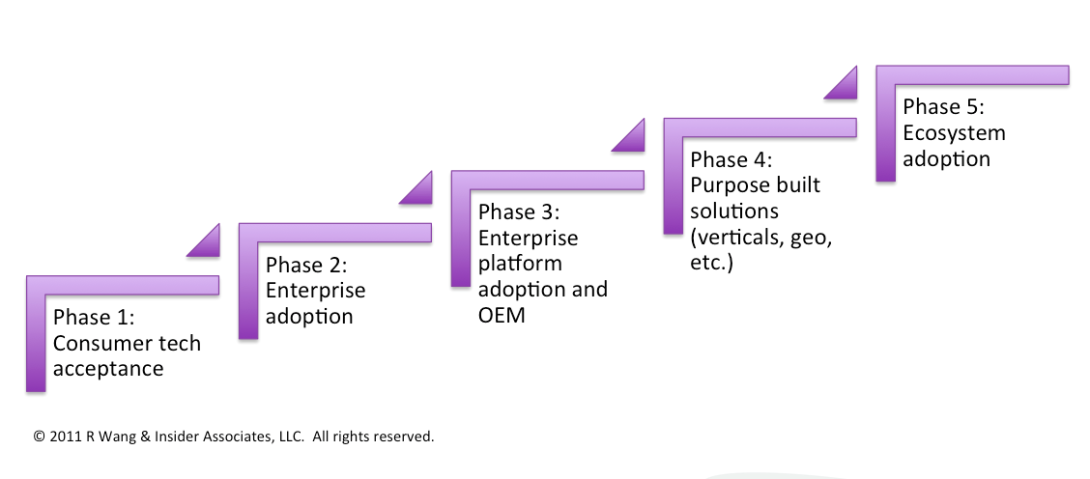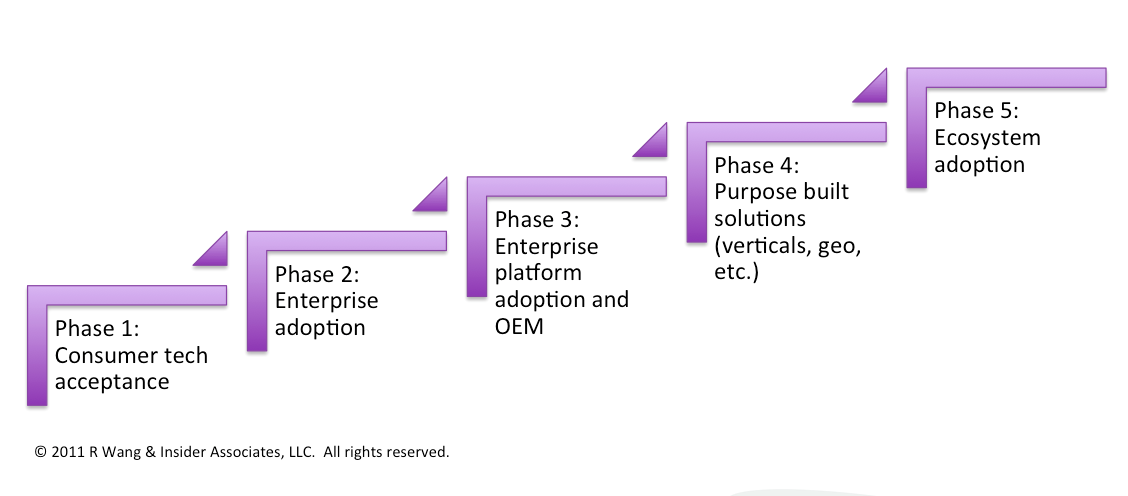
Monday's Musings: The Race For Enterprise Class Consumer Tech

Start Ups Chase Enterprise Dollars As Freemium Model Plays Out
I've been spending time with emerging technology start ups over the past 3 months. The good news - innovation in the valley is alive and well. Most of these ventures start with solving a consumer problem and hope for massive viral success in the freemium model. The bad news - the VC's hope for quick turnarounds that result in exit strategies to the deep pockets of Google, FaceBook, Microsoft, and Zynga. The sad truth - you and i know most will never make it. When that realization hits, the VC's hurry and move to the obvious next step - find an enterprise angle.
Consumer Tech Must Meet Five Elements To Earn Enterprise Class Status
To make it in the enterprise requires a mindset change. Business models focus on well... making money! We've spent much time coaching clients on how to move from freemium to premium. We also have to explain how an enterprise customer (i.e. CIO, CMO, Line of Business exec) may make a decision. Inevitably, our buy-side clients will ask, "Is this solution fit for the enterprise?" In a post from October about how consumer tech trends will enter the enterprise, we discussed the 5S' of for enterprise class software:
- Safe. Organizations expect these solutions to not only integrate with ease but also, not harm existing systems or jeopardize how users perform daily work and operations.
- Secure. More than just role based security mechanisms, these solutions should pass encryption requirements, prevent data intrusion, and protect key intellectual property assets.
- Scalable. Solutions should work in a wide range of environments, meet wide ranges of usage demands, and perform well across the globe. Users should be able to grow demand and scale down as well as up. Scaling up should lead to a lower cost per unit.
- Sustainable. Consumer technologies must meet requirements for flexibility and adaptability over longer periods of time (e.g. 7 to 10 years). Training programs, knowledge transfer mechanisms, and support communities should be readily accessible.
- Simple. Software vendors should employ design thinking to build solutions based on how people want to use mobile, social, analytics, video, and cloud in an enterprise context. Enterprise software should deliver in an easy to roll out and use manner.
There are probably more criteria to add here and I encourage you to add your thoughts to the 5S of enterprise class. Kudos to Christian Pantel for his addition of the 5th S - Simple!
The Bottom Line: Adoption Of Consumer Tech Falls Into Five Phases Of Adoption By Enterprises
So how do enterprise customers view consumer tech? Most consumer tech products excel at simplicity and scalability which allow them to enter Phase 1 (see Figure 1). But to move further, they have to address safe, secure, and sustainable. Let's use the iPhone example for acceptance. So I get an iPhone and decide to connect it to the enterprise email system. I get a POP mail account and soon I want mobile web access to my CRM system. IT gets antsy about all this unsecured data and rightfully brings up the mobile device management issue. What happens if you lose the device? How will we make sure you get the latest updates on our company iPhone app? To make it to Phase 2, you the user has to prove its secure. To make it to Phase 3, the device can't interfere with other apps and create headaches for the team. And to get IT to build solutions for the iPhone, the solution has to be sustainable for Phase 4. At this point, everyone's using it and we're ready for Phase 5, Ecosystem adoption. Let's take a look at the five phases and how the four personas of the next generation CIO view adoption and business value:
-
Phase 1: Consumer tech acceptance. Early adopters with Chief Innovation Officer acceptance.
-
Phase 2: Enterprise adoption. Multiple divisions seek usage. Chief Innovation Officers working with Chief Integration Officers to make it work.
-
Phase 3: Enterprise platform adoption and OEM. Enterprise studies the issue to make sure that the solution doesn't interfere with other solutions. Chief Infrastructure Officers get involved to test infrastructure.
-
Phase 4: Purpose built solutions (verticals, geo, etc.). Business leaders look for ways to build on the platform. Here's where Chief Intelligence Officers will build purpose built apps for use now that its safe, secure, and scalable.
-
Phase 5: Ecosystem adoption. At this point, the solution is everywhere and within the ecosystem and among partner, customer, and supplier stakeholders.
Figure 1. The Five Phases Of Enterprise Acceptance For Consumer Tech
Your POV.
Looking at innovating with consumer tech apps? How do you keep up with disruptive technologies? Ready to share your consumer tech experiences? What's the CIO point of view? Add your comments to the blog or send us a comment at r (at) softwareinsider (dot) org or info (at) ConstellationRG (dot) com.
Let us know how we can assist with:
- Keeping your team updated on the latest innovative business models and disruptive technologies
- Assisting with consumer tech evaluation for the enterprise
- Building your business and IT strategy
Related Resources And Links
- 20101004 A Software Insider's POV - R "Ray" Wang "Research Report: How The Five Pillars Of Consumer Tech Influence Enterprise Innovation"
- 20090824 A Software Insider’s POV – R “Ray” Wang “Monday’s Musings: 10 Essential Elements For Social Enterprise Apps”
- 20100810 A Software Insider’s POV – R “Ray” Wang “Tuesday’s Tip: 10 SaaS/Cloud Strategies For Legacy Apps Environments”
- 20100720 A Software Insider’s POV – R “Ray” Wang “Tuesday’s Tip: Dealing With Vendor Threats For “All Or Nothing” Maintenance Agreements”
- 20100525 A Software Inisder’s POV – R ‘Ray’ Wang “Tuesday’s Tip: How To Evaluate Tech Projects For Business Value
- 20100511 A Software Insider’s POV – R “Ray” Wang “Tuesday’s Tip: How To Compare Total Ownership Costs”
- 20100322 A Software Insider’s POV – R “Ray” Wang “Tuesday’s Tip: Understanding The Many Flavors of Cloud Computing and SaaS”
- 20091208 A Software Insider’s POV – R “Ray” Wang “Tuesday’s Tip: 2010 Apps Strategies Should Start With Business Value”
- Research Report: The 18 Use Cases of Social CRM – The New Rules of Relationship Management
- Research Report: Next Gen B2B and B2C E-Commerce Priorities Reflect Macro Level Trends
- Research Report: The Upcoming Battle For The Largest Share Of The Tech Budget (Part 2) – Cloud Computing
- Research Report: The Upcoming Battle For The Largest Share Of The Tech Budget (Part 1) – Overview
Reprints
Reprints can be purchased through Constellation Research, Inc. To request official reprints in PDF format, please contact [email protected].
Disclosure
Although we work closely with many mega software vendors, we want you to trust us. For the full disclosure policy, stay tuned for the full client list on the Constellation Research website.
Copyright © 2011 R Wang and Insider Associates, LLC All rights reserved.
 R "Ray" Wang
R "Ray" Wang R "Ray" Wang
R "Ray" Wang